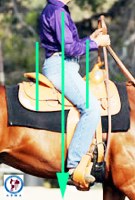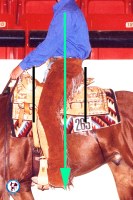THE RIDER
|
|||
The rider and the rider's horsemanship needs to be considered in saddle fit.
It is the rider’s responsibility to insure that their seat size, position, and balance are correct so the following possible problems are prevented.
|
|||
Seat size
|
|||
The saddle and the horse can have a positive fit, but if the riders’s seat size is wrong you may have a negative fit.
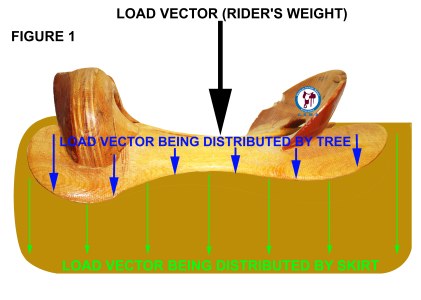 The primary purpose of a saddle/tree is to disperse the rider's weight evenly along the horse's back. This is the function of the tree bars and to some extent the skirts of the saddle (see FIGURE 1). When the rider's weight is centered the weight or load will be equally disbursed. The primary purpose of a saddle/tree is to disperse the rider's weight evenly along the horse's back. This is the function of the tree bars and to some extent the skirts of the saddle (see FIGURE 1). When the rider's weight is centered the weight or load will be equally disbursed.
In FIGURE 1 with the load vector centered the pressure is distributed by the tree equally as demonstrated by the blue arrows and the skirt also distributes the load vector equally as demonstrated by the green arrows. The amount of the rider's weight dispersed by the skirts is unknown. This is basic physics and can be demonstrated by placing a board on soft wet sand and applying pressure (load vector) in the center of the board. The result will be an exact impression of the board and will be the same depth along the sides and ends of the board.
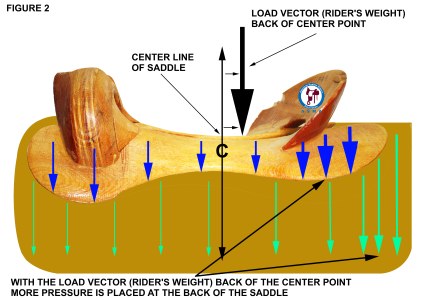 If the rider's weight is moved in front of the center or in back of the center (see FIGURE 2), the load vector will place more pressure to the front of the saddle in the case of a seat that is to small or more pressure to the back of the saddle with a seat that is to large.
In FIGURE 2 the load vector is moved away from the center line and the pressure distributed by the tree is un-equal as demonstrated by the blue arrows. The same apply's to the skirt as indicated by the green arrows. Again this is basic physics and can be demonstrated by placing a board on soft wet sand and this time applying pressure (load vector) away from the center of the board. This result will be an impression of the board where the depth of the impression will be deeper at the end closest to the load vector and will taper to the other end. The results of more pressure being applied to the back of the saddle may cause a negative saddle fit (see exhibit A). The seat being to large seems to be the prevailing case.
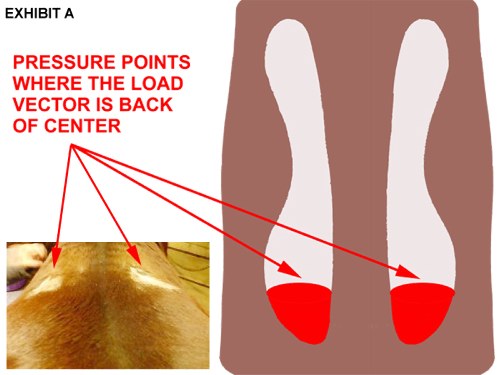
|
|||
Rider's position and balance
|
|||
"A crooked rider makes a crooked horse."
The saddle fits the horse and the rider, but if the is rider’s position and balance is off, the level of saddle fit will be diminished. As stated above, the primary purpose of the saddle is to distribute the rider’s weight evenly over the horse’s back. For the saddle to achieve this the rider must be centered. If the rider’s position and balance is off then the load vector on the saddle changes, thus effecting the level of positive saddle fit.
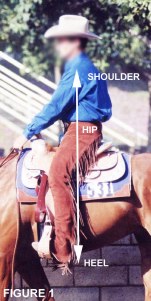 For the rider to be centered, along with seat size, they must be in the right position. With the rider sitting “tall” the saddle, back straight, shoulders square, chin up, and eyes looking forward, there should be a straight vertical line from the shoulder, to the hip, to the heel (see FIGURE 1). Some start with the ear. If the rider is leaning forward the load vector moves forward of center placing more pressure on the withers
(see FIGURE 2). With the rider leaning back the load vector moves back of center and will place more pressure on the hind quarters over the kidneys (see FIGURE 3). Simply stated, the rider needs to have their upper body and legs in balance so that if the horse was taken away, they will land on their feet. If the rider is behind the balance point with their legs out front, they will fall on their bottom. If the rider is forward of the balance point their legs are too far back, they will land on their nose.
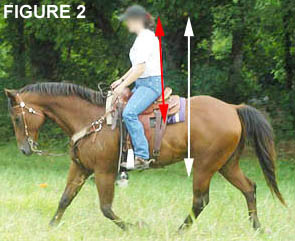 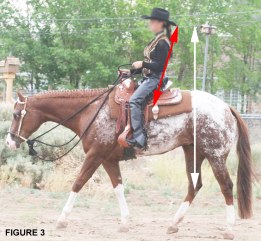 The rider also needs to be centered left to right. When the rider leans either to the left or to the right, the load vector will move off center in the direction of the rider is leaning (see FIGUREs 4 and 5). More pressure will be applied to the bottom of the tree bars on the side the rider is leaning towards and the top of the bars on the opposite side (see exhibits A and B). In FIGURE 4 the rider is leaning to the right and the saddle has shifted to the right and is not level left to right. Also, the stirrups are uneven, with the right stirrup lower than the left. FIGURE 5 illustrates the rider leaning to the left.
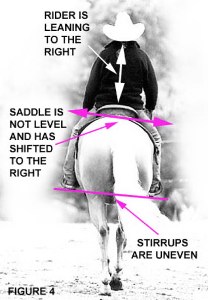 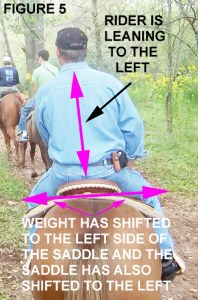 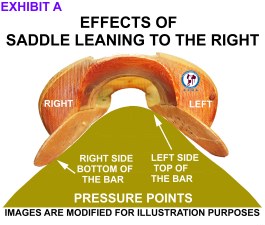 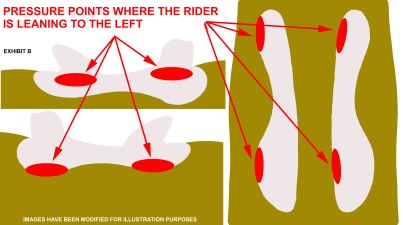 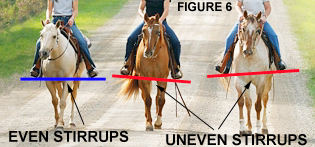 The reasons a rider would ride leaning one way or the other are many. The major culprits are: stirrup leathers that are uneven or the rider applying more pressure to one stirrup over the other
(see FIGURE 6). When a rider applies more pressure to one stirrup; the stirrup leather can stretch overtime and become uneven. In the English discipline riders switch their leathers periodically to compensate for the stretching. In the western discipline, the leathers can not be switched, so the stirrup leather buckles must be adjusted to compensate for the stretching. Also, the symmetry of the stirrup leathers may be unequal.
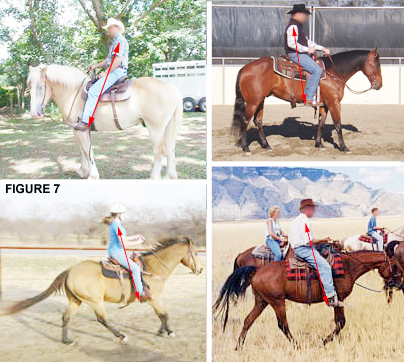 Some riders prefer to ride in what is termed the “chair” position (see FIGURE 7). When the rider is in this “chair” position the rider moves back into the cantle and the load vector is back of center and more pressure is applied to the back of the tree bars and saddle. (CLICK HERE for an example) Also, in this position when the rider applies pressure to the stirrups the rider is forced back into the cantle and the rider is said to be riding the cantle, as illustrated below
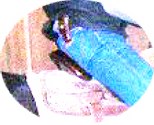 EDITORIAL NOTE: An established saddle maker related the following.
As a 35+ year member of a riding club that takes a 5 day yearly tail ride, he could anticipate a sore back horse at the end of the day by observing a rider’s level of horsemanship, position, and balance.
The final decision is up to the rider with the understanding that, if their position and balance is off; the level of positive saddle fit may be decreased.
|
|||
NOTE : The images are modified and exaggerated for illustration purposes. The actual measurements and differences are small and therefore are not easily discernable. The profiles of the body types are based on actual profiles.
|
e-mail mailto:info@saddlemakers.org
Copyright 2005 - 2016 American Saddle Makers Association, Inc.

